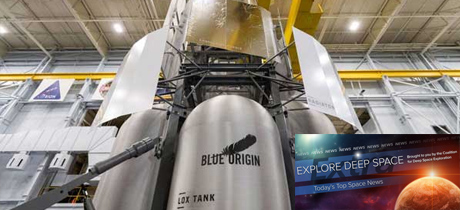New Episode of The Deep Space Podcast Available Now!
Tune in to the first episode of our new Human Exploration and Science Series, featuring Dr. Ellen Stofan, Director of the Smithsonian’s Air and Space Museum and formerly Chief Scientist of NASA. In this week’s episode, Dr. Stofan speaks about the rationale behind space science and human deep space exploration. For Stofan, who has spent time studying the behavior and composition of volcanoes on Mars, Venus and Saturn’s moon Titan, what really drives space science is understanding how the Earth works. Click here to listen now.
In Today’s Deep Space Extra… New research hints at possible life on Venus. The landing site for NASA’s Artemis 3 mission, which is to return human explorers to the surface of the Moon in 2024, is still under discussion.
Human Space Exploration
National team completes system requirements to define integrated Human Landing System (HLS) design
Coalition Members in the News – Lockheed Martin, Northrop Grumman
Parabolicarc.com (9/14): Earlier this year, a contractor team led by Blue Origin and including team members Lockheed Martin, Northrop Grumman and Draper was among three aerospace industry teams awarded contracts by NASA to pursue preliminary designs for a commercial lunar Human Landing System (HLS). The Blue Origin team has reached a significant milestone, completing its System Requirements Review. There is more that has been completed, including arriving at human and health performance standards.
Bridenstine: Returning to Apollo landing sites offers advantages
Coalition Members in the News – Dynetics, Lockheed Martin, Northrop Grumman
Spacepolicyonline.com (9/14): Speaking Monday before NASA’s Lunar Exploration Analysis Group (LEAG), NASA Administrator Jim Bridenstine said there could be scientific as well as inspirational benefits if the agency had to choose a 2024 return to the surface of the Moon with human explorers near Apollo landing sites rather than at the lunar south pole, the site of suspected large deposits of water ice, a significant future resource. Though NASA’s Artemis strategy has been a return in 2024 with a south pole landing, Bridenstine said a formal decision has yet to be made.
Moon and Mars advocates find peace
Coalition Member in the News – Lockheed Martin
The Space Review (9/14): A look at why it is the Moon and Mars, not one or the other that should be the next destination for human deep space exploration. Debate over which should be next after NASA’s Apollo missions to the Moon between 1969 and 1972 has been a source of long-standing political division. The Republicans say the Moon, then Mars and Democrats say go to Mars, we have been to the Moon. Increasingly, it’s looking as though research and development at the International Space Station (ISS) and human activities on the Moon are needed to pave the way to Mars, writes Space Review editor Jeff Foust.
Space Science
Life on Venus? Astronomers see a signal in its clouds
New York Times (9/14): Nearly two dozen scientists from Britain, the U.S. and Japan reported Monday on Earth based telescope studies of the high altitude atmosphere of Venus in which they detected small concentrations of phosphine, a phosphorus/hydrogen gas, that may have originated with biological activity within the upper altitude cloud layers. More telescope observations may be warranted as well as new missions to Venus mission to further check out the origin of the phosphine.
Will NASA choose a Venus mission after phosphine discovery?
Spacepolicyonline.com (9/14): Following a planetary science research announcement on Monday regarding the discovery of traces of phosphine in the atmosphere of Venus using Earth-based telescopes, NASA Administrator Jim Bridenstine expressed interest in launching new missions to the sister planet. Two are currently under evaluation at NASA, DAVINCI+ to study the planet’s atmospheric chemistry and VERITAS, an orbiter for mapping the cloud covered surface with synthetic aperture radar and other instrumentation.
Japan’s Hayabusa2 aims to probe asteroid “1998KY26” in 2031
Kyoto News of Japan (9/15): Japan’s Hayabusa 2 asteroid sample return mission has a new destination after it drops off surface and subsurface samples of the distant asteroid Bennu in December. Launched in December 2014, Hayabusa 2 will continue on to a small asteroid designated 1998KY26 that orbits between the Earth and Mars, arriving in 2031. The samples of asteroid Ryugu were collected by the space probe in 2019 and may help to further explain how water and organics, the building blocks of life, were distributed during the early planet forming process.
Op Eds
Venus may hold the answers about life we’ve been looking for
Washington Post (9/14): In an op-ed, Cornell University planetary science professor Jonathan Lunine urges further investigation of the possibility of life forms in the atmosphere of Venus, a notion advanced more than 50 years ago by the late astronomer Carl Sagan. The trace phosphine gas discovery in clouds of Venus, if verified with a future mission, could become a biosignature in the search for life on planets beyond the solar system using future space observatories, Lunine explains.
The West needs bold, sustainable, and inclusive space programs and visions, or else
The Space Review (9/14): NASA is not the only space agency with a focus on establishing a human presence on the Moon with international and commercial partners. China does as well. However, China’s intentions outlook may not be as generous as NASA’s, writes Giulio Prisco, a science and technology writer and former European Space Agency (ESA) analyst. Prisco cautions the outcome of the November U.S. congressional as well as presidential election could give China the edge. “Our space programs and visions must be bold, because that’s the only way to rekindle public enthusiasm for space,” he writes.

